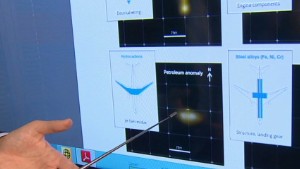MH370 report: Mixed messages ate up time before official search initiated
May 1, 2014 -- Updated 1922 GMT (0322 HKT)
STORY HIGHLIGHTS
- Reassuring messages from airline were "unhelpful," aviation correspondent says
- While the plane was missing, time ticked away
- Report shows a 4-hour gap from when the plane left radar to when the official search began
- The plane probably had enough fuel to last through that gap and for another 2½ hours
(CNN) -- Confusion, misleading information and then long periods of nothing marked the first hours of what's now known as the disappearance of Malaysia Airlines Flight 370.
It took air traffic controllers more than four hours after the last conversation with the cockpit to activate rescuers to look for the missing plane, which left Kuala Lumpur, Malaysia, on March 8 with 239 people on board.
Some delays in communication with an airliner over the ocean are normal, says CNN aviation correspondent Richard Quest.
But time was of the essence, and eventually, a lot was lost.
The plane probably ran out of fuel about 7½ hours into the flight, a Malaysia Airlines official has said. That means MH370 might have been flying during that four-hour gap.





If so, it seems the Boeing jet only had 2½ hours of fuel left when rescuers first began searching for it.
'Good night, Malaysian Three Seven Zero'
The flight radioed its last words to the Kuala Lumpur Air Traffic Control Centre at 1:19 a.m. local time, according to an attachment to a preliminary report by Malaysia's Transportation Ministry. The report was released to the public Thursday.
The report itself is scant. Just five pages in length, it contains only a small fraction of the content of similar preliminary reports from past air disasters.
But combined with the air traffic transcript also released to the public, it gives a picture how the first hours progressed after MH 370 signed off.
Controllers told the airliner to check in with their counterparts in Ho Chi Minh City, Vietnam. "Good night, Malaysian Three Seven Zero," someone in the cockpit answered.
That check-in never happened, but something else did. The plane dropped off radar, and the clock ticked.
"Control of the aircraft had left Malaysia to Vietnam. Even so, for 17 minutes, neither Kuala Lumpur nor Ho Chi Minh noticed nor acted," Quest said.
Then at 1:38 a.m., Ho Chi Minh contacted Kuala Lumpur to let the controllers know that it had not heard a word from the plane. "Verbal contact was not established," the transcript said.
The two control centers began a conversation about communications attempts with Flight 370 and previous radar blips along its path.
They spoke every few minutes.
Reassuring messages cost precious time
Then two messages came from Malaysia Airlines that may have taken more precious time.
At 2:03 a.m. came the first seemingly reassuring message from the airline. The plane was in Cambodian airspace, the airline told Kuala Lumpur air traffic control.
The Malaysians passed the message on to Vietnamese controllers. They then tried to confirm Malaysia Airlines' news with Cambodian air traffic controllers.
The airline later confirmed its reassuring message. It had been able to "exchange signals with the flight," which was in Cambodian airspace, the transcript read.
But an hour after Flight 370 signed off, Vietnamese air controllers poked holes in Malaysia Airlines' message. The flight had not been scheduled to fly over Cambodia, and officials there had no information on the plane -- nor contact with it.




Malaysian air traffic controllers kept in communication with the airline, which gave them yet another seemingly reassuring message at 2:35 a.m.
The airliner was "in normal condition based on signal download," which placed it off the coast of Vietnam.
The flight probably appeared to be on track to its destination of Beijing.
"We have two very unhelpful contributions from Malaysia Airlines -- one suggesting the plane is in Cambodia, the other saying everything's normal. Neither's true," Quest said.
Information 'not reliable for aircraft positioning'
If precious time had been lost by the trickle before, now it began to gush away.
Nearly an hour later, Malaysia Airlines qualified its previous information. Its new message: "The flight tracker information was based on flight projection and not reliable for aircraft positioning," the transcript read.
It was 3:30 a.m., but two more hours would pass before air traffic controllers notified rescuers.
In the meantime, controllers in Kuala Lumpur and Ho Chi Minh City queried each other and the airline. Kuala Lumpur air traffic control contacted counterparts in Singapore, Hong Kong and Beijing.
Then at 5:20 a.m., a Malaysian official pronounced, based on what was known, "MH370 never left Malaysian airspace."
Ten minutes later, Malaysian air traffic controllers alerted a rescue coordination center.
Where was the military?
The Malaysian Prime Minister has said the military tracked the plane as it headed back across Malaysia.
According to the report, a playback of a recording from military primary radar revealed that an aircraft that may have been Flight 370 had made a westerly turn, crossing Peninsular Malaysia. The search area was then extended to the Strait of Malacca.
But it's unclear when that happened. The report makes no mention of the military's role the night of the disappearance.
The report is anemic on details
Preliminary reports are by their nature brief and to the point, but they are usually much longer than Malaysia's. Such reports and accompanying documents should be an audit of what happened and factually who did what, Quest said.
"I can certainly understand that the authorities had more pressing matters in finding the plane than writing a long report, when there will be plenty of other chances to do so," Quest said, "but this report is the barest possible they could get away with."
The equivalent preliminary report on Air France Flight 447 was 128 pages long. That report, produced by France's aviation safety agency just one month after the plane went missing in 2009, offered specific details on communication between various air traffic control centers.
Flight 447 was found more than a year later in the Atlantic Ocean; all 228 people on board had died.
And a preliminary report by the Australian Transport Safety Bureau into the Qantas engine explosion in 2010 ran more than 40 pages, including diagrams and charts.
The Malaysian report was accompanied by a cargo manifest, seating plan, air traffic control transcripts and three maps.
Debate over transparency
The report released Thursday was the same one Malaysia submitted to the International Civil Aviation Organization but had not been made public. Malaysian officials came under heavy criticism last week for submitting the report to the U.N. body but not making it available to relatives of passengers.
While authorities are not required to make a preliminary report public, Malaysian Prime Minister Najib Razak acquiesced.
Reporters could not ask questions raised by the report since the document was released by e-mail and not at a news conference.
One safety recommendation
The report makes one safety recommendation: the need for real-time tracking.
Authorities noted that while commercial planes spend considerable time operating over remote areas, there is no requirement for real-time tracking of such aircraft.
"There have now been two occasions during the last five years when large commercial air transport aircraft have gone missing and their last position was not accurately known," the Malaysian report states. "This uncertainty resulted in significant difficulty in locating the aircraft in a timely manner."
CNN reported on this detail from the report last week.
The officials asked the International Civil Aviation Organization to examine the benefits of introducing a standard for real-time tracking of commercial planes.
It's the same recommendation that was made after the Air France Flight 447 disaster in 2009. But nothing seems to have happened after that report.

No comments:
Post a Comment